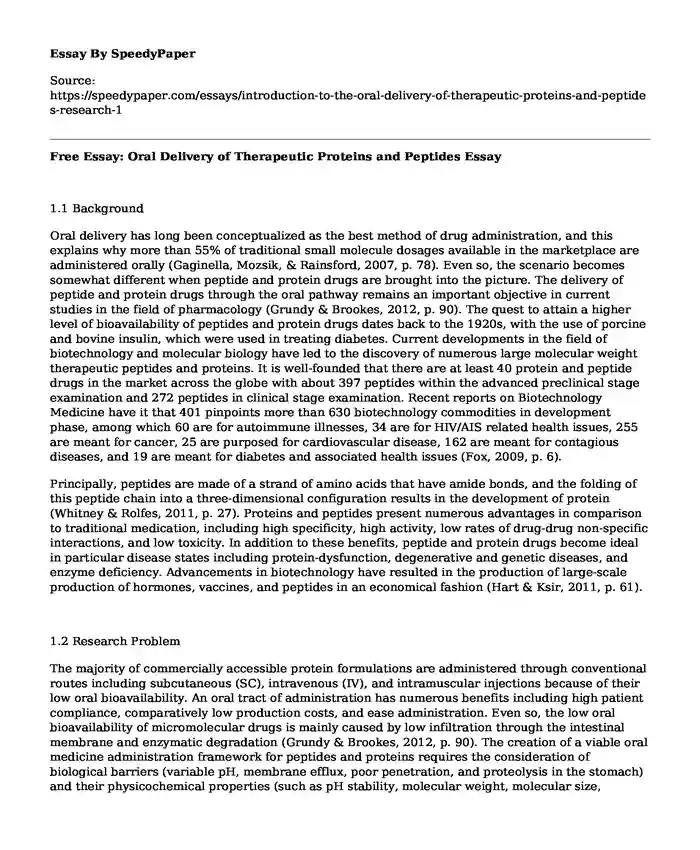1.1 Background
Oral delivery has long been conceptualized as the best method of drug administration, and this explains why more than 55% of traditional small molecule dosages available in the marketplace are administered orally (Gaginella, Mozsik, & Rainsford, 2007, p. 78). Even so, the scenario becomes somewhat different when peptide and protein drugs are brought into the picture. The delivery of peptide and protein drugs through the oral pathway remains an important objective in current studies in the field of pharmacology (Grundy & Brookes, 2012, p. 90). The quest to attain a higher level of bioavailability of peptides and protein drugs dates back to the 1920s, with the use of porcine and bovine insulin, which were used in treating diabetes. Current developments in the field of biotechnology and molecular biology have led to the discovery of numerous large molecular weight therapeutic peptides and proteins. It is well-founded that there are at least 40 protein and peptide drugs in the market across the globe with about 397 peptides within the advanced preclinical stage examination and 272 peptides in clinical stage examination. Recent reports on Biotechnology Medicine have it that 401 pinpoints more than 630 biotechnology commodities in development phase, among which 60 are for autoimmune illnesses, 34 are for HIV/AIS related health issues, 255 are meant for cancer, 25 are purposed for cardiovascular disease, 162 are meant for contagious diseases, and 19 are meant for diabetes and associated health issues (Fox, 2009, p. 6).
Principally, peptides are made of a strand of amino acids that have amide bonds, and the folding of this peptide chain into a three-dimensional configuration results in the development of protein (Whitney & Rolfes, 2011, p. 27). Proteins and peptides present numerous advantages in comparison to traditional medication, including high specificity, high activity, low rates of drug-drug non-specific interactions, and low toxicity. In addition to these benefits, peptide and protein drugs become ideal in particular disease states including protein-dysfunction, degenerative and genetic diseases, and enzyme deficiency. Advancements in biotechnology have resulted in the production of large-scale production of hormones, vaccines, and peptides in an economical fashion (Hart & Ksir, 2011, p. 61).
1.2 Research Problem
The majority of commercially accessible protein formulations are administered through conventional routes including subcutaneous (SC), intravenous (IV), and intramuscular injections because of their low oral bioavailability. An oral tract of administration has numerous benefits including high patient compliance, comparatively low production costs, and ease administration. Even so, the low oral bioavailability of micromolecular drugs is mainly caused by low infiltration through the intestinal membrane and enzymatic degradation (Grundy & Brookes, 2012, p. 90). The creation of a viable oral medicine administration framework for peptides and proteins requires the consideration of biological barriers (variable pH, membrane efflux, poor penetration, and proteolysis in the stomach) and their physicochemical properties (such as pH stability, molecular weight, molecular size, ionization contact, and hydrophobicity) that prevent the absorption of such drugs from the gastrointestinal tract. Regardless of these setbacks, a few polypeptide dosages, including cyclosporine and desmopressin have been developed in the form of oral-drugs. Large pharmaceutical organizations and educational institutions have intensified their study activities towards oral protein and peptide administration over the recent few decades (Hart & Ksir, 2011, p. 61). As such, the current study is geared to explore the physiological constraints to oral delivery of proteins and peptides and strategies to improve the bioavailability of these types of drugs. In essence, the researcher considers the following to be the problems of the current study:
To explore the pharmaceutical strategies to augment oral bioavailability of therapeutic peptides and proteins
1.3 Research Purpose
The subsequent section summarizes the questions that the researcher intends to answer in the perspective literature-based study
13.1 Research Questions
1. What are the mechanisms through which protein and peptide drugs get absorbed in the gastrointestinal tract?
2. What are the factors that hinder the absorption of therapeutic proteins and peptides in the gastrointestinal tracts?
3. What are the strategies to improve the oral delivery of protein and peptide drugs in the gastrointestinal tract?
1.3.2 Research Objectives
The researcher considers the following to be the key objectives of the study to come:
1. To explore the mechanisms through which protein and peptide drugs get absorbed in the gastrointestinal tract;
2. To investigate the factors that hinder the absorption of therapeutic proteins and peptides in the gastrointestinal tracts; and
3. To suggest strategies to improve the oral delivery of protein and peptide drugs in the gastrointestinal tract
Cite this page
Free Essay: Oral Delivery of Therapeutic Proteins and Peptides. (2017, Sep 05). Retrieved from https://speedypaper.com/essays/introduction-to-the-oral-delivery-of-therapeutic-proteins-and-peptides-research-1
Request Removal
If you are the original author of this essay and no longer wish to have it published on the SpeedyPaper website, please click below to request its removal:
- Bulgaria Suffering from Deflation Essay Sample
- Department Chair Action Plan - Free Essay in Education Management
- Essay Sample on Genetically Modified Organisms
- Check the Example of Work Placement Reflection Essay
- Project Review Paper Example
- Free Essay on the Team Works in Organizations
- Free Essay Example: Spiritual (Moral) Self
Popular categories





